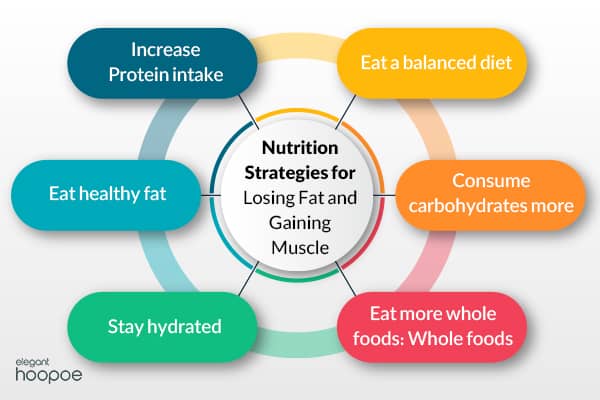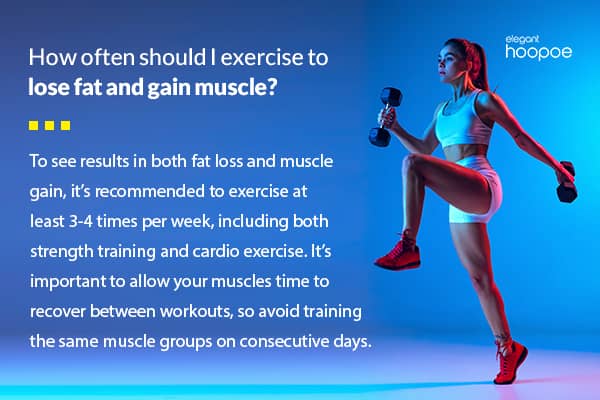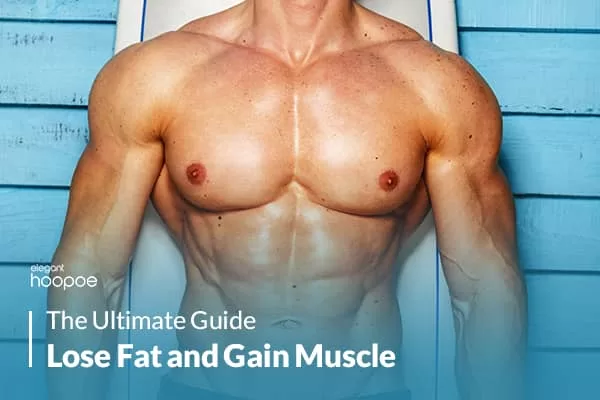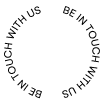How to Lose fat and gain muscle at the same time?! Are you tired of yo-yo dieting and not seeing any significant changes in your body? Losing fat and gaining muscle can be a challenging feat. Many people believe that they need to focus solely on one goal, either losing fat or gaining muscle, and then switch their focus to the other goal.
But it is possible to burn fat and gain muscle with the right mindset, plan, and execution. Burning fat and gaining muscle are two of the most popular fitness goals, but can you achieve both simultaneously?
Some people believe that losing fat and gaining muscle at the same time is impossible! while others swear that it’s possible with the right approach. In this comprehensive guide of Elegant Hoopoe, we will cover everything you need to know about losing fat and gaining muscle, including the science behind it, the best nutrition and exercise strategies, and how to stay motivated throughout the process.
See our:
icoone treatment reviews
truSculpt Flex before and after
Gaining muscle While Losing Fat
Can you burn fat and gain muscle at the same time? The answer is it depends. The human body can only gain or lose weight at a certain rate. To lose fat, you need to be in a calorie deficit, which means consuming fewer calories than your body needs. To gain muscle, you need to be in a calorie surplus, which means consuming more calories than your body needs. So, how can you achieve both goals simultaneously? It’s a matter of finding the right balance.

The idea of losing fat and gaining muscle simultaneously is known as body recomposition. This means that you are trying to change your body composition. Body composition is the ratio of fat to muscle in your body. To achieve body recomposition, you need to be in a slight calorie deficit while consuming enough protein to maintain and build muscle. You also need to engage in regular resistance training, which is essential for building muscle and maintaining strength.
Read more: Build muscles in the buttocks It is a frequent request among women 20 best Butt exercises can help you build strength, increase muscle mass, and achieve your fitness goals.
However, it’s worth noting that body recomposition is a slow process. You can’t expect to see significant changes in a short amount of time. It’s also important to note that the more experienced you are, the harder it is to achieve body recomposition.
Losing fat and gaining muscle at the same time usually requires a combination of resistance training, cardiovascular exercise, and a healthy diet that provides the necessary nutrients for muscle growth and recovery. The key to successful body recomposition is to maintain a caloric deficit to lose fat while providing your body with sufficient protein and nutrients to support muscle growth.
Related article: pear shaped body
The Science Behind Losing Fat and Gaining Muscle
To lose fat, you need to create a caloric deficit by burning more calories than you consume. This can be achieved through a combination of diet and exercise. Reducing your daily caloric intake by 500 calories and burning an additional 500 calories through exercise can result in a weekly deficit of 3500 calories, which is equivalent to one pound of fat loss per week.
To gain muscle, you need to create a caloric surplus by consuming more calories than you burn. This surplus provides the energy your body requires to repair and build bigger muscles. You also need to engage in strength training, which places challenging stress on muscle fibers, to promote muscle growth.
To achieve both goals simultaneously, you need to find the right balance between a caloric deficit and a caloric surplus. This can be achieved by eating a balanced diet that is high in protein and low in processed foods and sugars. Engaging in both cardio and strength training exercises is also essential for achieving both goals at the same time.

Diet and Nutrition plan to lose fat and gain muscle
To achieve both goals, it is important to focus on nutrition. Nutrition is a crucial factor in losing fat and gaining muscle. Here are some of the best strategies to help you lose fat gain muscle and achieve your goals:
Eat a balanced diet
A balanced diet is high in protein and low in processed foods and sugars. Protein is essential for muscle growth, while processed foods and sugars can lead to weight gain and a decrease in overall health.
Increase Protein intake
Protein is the building block of muscle and is essential for muscle growth and repair. Aim to consume 1-1.2 grams of protein per pound of body weight daily. Good sources of protein include chicken, fish, eggs, and plant-based options like tofu and lentils.
Consume carbohydrates more
Carbohydrates provide your body with energy for your workouts and daily activities. Aim to consume complex carbohydrates like whole grains, fruits, and vegetables, and avoid simple carbohydrates like sugary drinks and processed foods.
Eat healthy fat
Healthy fats like olive oil, nuts, and avocados are essential for hormone production and overall health. Aim to consume 20-30% of your daily calories from healthy fats.
Eat more whole foods: Whole foods
such as fruits, vegetables, lean meats, and whole grains. These foods are nutrient-dense and can help you feel full for longer, which can help you stick to your diet and achieve your goals.
Stay hydrated
Stay hydrated by drinking plenty of water throughout the day. Water is essential for overall health and can also help you feel full, which can prevent overeating. Staying hydrated is essential for optimal body function and can also help with weight loss. Aim to drink at least eight glasses of water per day.

For those who are following a vegetable-based diet and lifestyle, consuming plant-based protein is recommended. Here’s a list of plants that are rich in different proteins:
- beans, chickpeas, lentils and soybeans
- Nuts
- Seeds
- Tofu
- Tempeh
Although protein is crucial to our health, too much of it can put our health at risk. It is best to consult with a doctor or a health care provider to see how much protein you should take during the day, otherwise, you might end up consuming more than you should which could result in kidney-related problems.
Related treatment:
Best Exercises for Losing fat and gaining muscle
Remember that your muscle cells need energy to function and to grow and too much calorie deficit is not going to help you at all, instead, if you do not provide your body with enough energy, it is more likely to lose muscle instead of fat, and this is the last thing you want!
Losing muscle will not only affect your strength but also slow down your metabolism, making it harder to lose weight.

To gain muscle, you need to provide your muscles with enough stimulus to grow. This can be achieved through resistance training, which involves lifting weights or using resistance bands. Resistance training causes micro-tears in your muscle fibers.
Workout tips to gain muscle and lose fat simultaneously
Exercise is a critical component of losing fat and gaining muscle. Here are some of the best strategies to help you achieve your goals:
- Do resistance exercise: Resistance training is the most effective exercise for gaining muscle. Aim to perform resistance training 2-3 times per week, targeting all major muscle groups. Start with a weight that allows you to perform 8-12 repetitions per set and gradually increase the weight as you become stronger.
- Do cardiovascular exercise: Cardiovascular exercises like running, cycling, and swimming can help you burn calories and lose fat. Whether you’re a beginner or a professional, the key is to include both cardio and strength training in your workout routine. Cardio without strength training can compromise your muscle mass (shrink it instead of building it), But strength training without cardio can compromise your fat loss. So do both.
- HIIT: High-intensity interval training is another type of workout that is going to help you lose more fat while also shape your muscles. These trainings are known to be demanding and not everybody is able to do them as they can put a lot of pressure on the body, the key is to start HIIT in a really light and slow way and then after your body has adapted to the pressure then, you can start following up on a more intense way. It is important to the HIIT once or twice a week, and remember that putting too much pressure on the body can lead up to overstress and it will inhibit muscle growth.
- Prioritize sports based on your goals: Even if you include cardio and strength training in your training, you don’t need to prioritize both. If you are a marathon runner, focus on your cardiovascular endurance. If you are a bodybuilder, focus on building muscle. For beginners or regular athletes, having a balance between the two is the best way to burn fat and build muscle at the same time. Also, remember that you may lose fat without losing weight, so your scale may not be a good indicator of your progress.
- Dedicate enough time to muscle recovery: Exercising too much, or not resting enough to allow the body to recover between workouts, may cause both fat loss and muscle burning. Additionally, it can increase your risk of injury and make it harder to exercise for weight loss. If you notice that your workout performance is declining or you feel tired, take a day or two off. Allow your muscles to fully recover so you don’t injure yourself too much.

Easy way of gaining muscle and losing fat at the same time
Following up on an exercise and diet plan is not always the easiest thing to do, it requires time and dedication, and seldom do people find a plan that suits their body and overall health. But, there are other methods that can help in losing weight and gaining more muscle at the same time. For instance, If you find it hard to lose those stubborn fat pockets in your abdomen area, you can use other methods to destroy those fat cells, for instance, fat removal in Dubai without any surgery is a popular option for those who would like to see their body transform faster however, exercise and diet are still recommended to achieve maximum results.
There are also other methods that genuinely focus on muscle and some devices can stimulate muscle contractions in a short period, resulting in more shaped and toned muscle tissues around the body. Although these methods and procedures have proven to be effective, Elegant Hoopoe Weight Management Clinic does not recommend them in the first place, working out and having a well-planned diet is always going to be the better way despite the fact that it will take time the desired results. But, if you are considering these non-invasive methods for muscle toning and fat reduction, you can call our experts any time and they will give you a full consulting session on what is the best way for you to reach your goals.
Related article:
Concluding remarks
If you’re interested in achieving body recomposition, here are some tips to help you get started:
Do not focus on your weight: Body recomposition is different to weight loss. when your aim is to gain muscle while also losing some fat, your eight might as well increase to some extent and you do not need to be worried about it. Muscle tissue is much denser than fat pockets just gaining one or two sizes is going to increase your weight no matter how much fat you have lost.
Focus on your diet: To achieve body recomposition, you need to be in a calorie deficit while consuming enough protein to maintain and build muscle. Make sure you’re eating a balanced diet that’s rich in protein, healthy fats, and complex carbohydrates. Avoid crash diets or extremely low-calorie diets, as they can cause muscle loss and are not sustainable long-term.
Engage in resistance training: Resistance training is essential for building muscle and maintaining strength. Make sure you’re incorporating strength training into your workout routine at least three to four times per week. It’s essential to challenge your muscles progressively over time to continue seeing results. This can be achieved by gradually increasing the weight you lift or the number of repetitions you perform.
Be patient: Body recomposition is a slow process, and it can take months or even years to achieve significant changes. Don’t get discouraged if you don’t see results right away. Stay consistent with your diet and workout routine, and the results will come.







